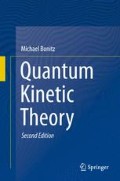Abstract
This chapter restores the spin statistics in the many-body equations derived in Sect. 3.2. This means all operators and equations are properly symmetrized (for bosons) or anti-symmetrized (for fermions) following an idea of Dufty and Boercker in [102]. This directly yields key quantities such as the Hartree-Fock mean field, Pauli blocking factors (for fermions) and many-body renormalized pair potentials. The final results are the properly (anti-)symmetrized equations of motion for the one-particle density operator and the two-particle and three- particle correlation operators.
Access this chapter
Tax calculation will be finalised at checkout
Purchases are for personal use only
Notes
- 1.
This chapter (as all sections marked with “\(*\)”) may be skipped on first reading.
- 2.
We mention that frequently another definition is used where \(\Lambda ^{\pm }\) includes the normalization prefactor \(1/\sqrt{N!}\).
- 3.
This result is correct if no orbital is occupied more than once. In the case of bosons, multiple occupations \(n_1, n_2, \dots \) of individual orbitals are possible, leading to a modified normalization condition

- 4.
This duality is analogous to the Heisenberg and Schrödinger pictures of quantum mechanics.
- 5.
The destruction of the commutator form has nontrivial consequences for the analysis of the time reversibility and the conservation properties, which we discuss in Sect. 3.4.2.
- 6.
This comes from nuclear matter or solid state terminology where excitation of a particle from a certain energy level or band leaves behind a “hole” (or anti-particle) that behaves like a particle itself.
- 7.
- 8.
- 9.
cf. Appendix C.3.
- 10.
On the other hand, an approximation that neglects all exchange terms consistently (in the collision term of the first hierarchy equation, in the Hartree-Fock terms in \({\bar{H}}_{12}\), in the polarization terms and so on), but includes the Pauli blocking terms, will still be conserving, since the latter have no influence on the conservation properties. This is most easily verified from (3.33), where the direct and exchange terms may be collected in two groups of terms which each independently has the noted properties.
Author information
Authors and Affiliations
Corresponding author
Rights and permissions
Copyright information
© 2016 Springer International Publishing Switzerland
About this chapter
Cite this chapter
Bonitz, M. (2016). \(*\)Correlations Due to the Spin Statistics. In: Quantum Kinetic Theory. Springer, Cham. https://doi.org/10.1007/978-3-319-24121-0_3
Download citation
DOI: https://doi.org/10.1007/978-3-319-24121-0_3
Published:
Publisher Name: Springer, Cham
Print ISBN: 978-3-319-24119-7
Online ISBN: 978-3-319-24121-0
eBook Packages: Physics and AstronomyPhysics and Astronomy (R0)


